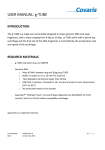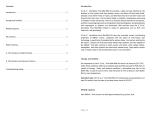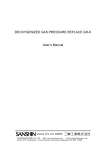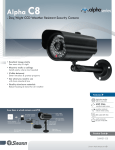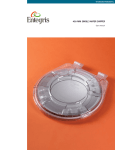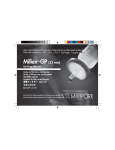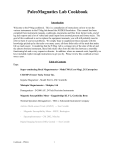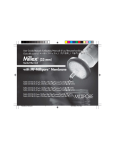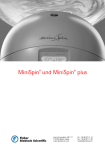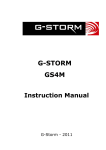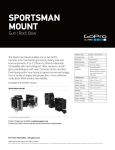Download USER MANUAL: g-TUBE
Transcript
USER MANUAL: g-TUBE INTRODUCTION The g-TUBE is a single use consumable designed to shear genomic DNA into large fragments, with a mean ranging from 6 kbp to 20 kbp. g-TUBE works with a bench top centrifuge and the final size of the DNA fragments is controlled by the acceleration rate and speed of the centrifuge. USER SUPPLIED MATERIALS - Genomic DNA o Mass of DNA: between 4µg and 30µg per g-TUBE o Buffer: DI water or TE or 10 mM Tris-Cl pH 8.5 o Non degraded, starting size larger than 45 kbp o DNA fully in solution, vortexed for 10s and pre warmed at room temperature (20°C to 30°C) o No particulate matter in the sample - Eppendorf® “MiniSpin® plus” microcentrifuge (Eppendorf pn 022620207 for 110V version). See #1 in FAQ for others compatible centrifuges. SUPPLIES Part Number g-TUBE (10) g-TUBE Case (100) g-TUBE Prep Station (10) 520079 520104 500291 eppendorf® is a registered trademark. Part Number: Date: 010154 Rev C June, 2012 1|P a g e PROTOCOL The objective is to have the sample pass two times through an orifice at a controlled rate. The first spin is to transfer the sample to the bottom of the tube. The second spin is to transfer the sample from the bottom of the tube and into the cap. 1- Place the g-TUBE in the LOAD position of the stand, screw-cap up 2- Remove the screw-cap from the g-TUBE and load 150ul of sample into the top of the tube a. Please ensure that your sample is free from particulate matter and the DNA is fully dissolved. If in doubt please see #5 in the FAQ section 3- Close the g-TUBE a. Screw the cap on very firmly - Please see #11 in the FAQ section if you are unable to screw the cap on very firmly by hand b. Proceed to the next step within 15 minutes Part Number: Date: 010154 Rev C June, 2012 2|P a g e 4- Load the g-TUBEs (screw-cap up) into the centrifuge. If necessary, use an extra g-TUBE to balance the rotor. a. Set the centrifuge to the speed specified in Table 1. Spin the samples for the Processing time listed in Table 1. b. Remove the g-TUBEs from the centrifuge; visually check to determine if the entire sample has drained from the upper chamber of the g-TUBE, if not see #6 in FAQ section. Part Number: Date: 010154 Rev C June, 2012 3|P a g e Eppendorf® 5424 and 5415 R centrifuges – Speed (RPM) Targeted size Mass of DNA 6 kbp 8kbp 10 kbp 20 kbp 4 µg 8 µg 15 µg 30 µg 11,000 7,200 6,000 4,200 11,000 7,200 6,000 4,800 13,200 8,600 7,200 5,800 13,200 10,000 8,600 7,200 30 sec 60 sec 60 sec 60 sec Processing time (seconds) Eppendorf® MiniSpin plus – Speed (RPM) Targeted size Mass of DNA 6 kbp 8kbp 10 kbp 20 kbp 4 µg 8 µg 15 µg 30 µg 14,500 9,400 8,000 5,500 14,500 9,400 8,000 6,300 -* 11,200 9,400 7,600 -* 13,000 11,200 9,400 30 sec 60 sec 60 sec 60 sec Processing time (seconds) Table 1 – Use these tables to determine the centrifuge speed (RPM) for the amount of DNA and the targeted DNA fragments size. (*) These combinations are not available with Eppendorf MiniSpin plus centrifuge Acceleration should never exceed 16000g (or RCF) Part Number: Date: 010154 Rev C June, 2012 4|P a g e 5- Invert the g-TUBEs, place them in the rotor (screw-cap down) and spin them again using the same speed and duration. a. Proceed to the next step within 15 minutes 6- Transfer the g-TUBE from the centrifuge to the UNLOAD position of the stand, keeping the screw-cap down all the time. 7- Unscrew the tube body leaving the screw-cap containing the sample in the stand. Recover the sample from the screw-cap. You may tilt the stand to aid sample recovery. Part Number: Date: 010154 Rev C June, 2012 5|P a g e Trouble shooting / Frequently Asked Questions (FAQ) 1. - Which centrifuges are compatible? Eppendorf MiniSpin plus Eppendorf Model 5415 R with temperature set at 30°C Eppendorf Model 5424 2. What is the range of sample volumes? - g-TUBE is validated for use with 150µl sample. Other sample volumes will affect the result. 3. Is it possible to store sample in a g-TUBE? - No, the sample has to be processed within 15 minutes after loading and removed from the g-TUBE immediately after processing. 4. I didn’t recover my entire sample, what happened? - If the g-TUBE screw-cap isn’t tightly closed, some sample may move into the screw threads. The sample isn’t lost and is recoverable. First, pipette out the sample in the cap, then close the tube and spin it (screw-cap down) at low RPM for a few seconds. You can now pipette the remaining sample from the cap. 5. My DNA isn’t fully in solution or I have impurities in my sample. - Incubate the DNA in a microcentrifuge tube for 20min at 35C, vortex frequently and then centrifuge your sample at 14,000 RCF for 15min to pellet DNA that isn’t in solution. - You can also filter the sample using a small filtration device with 0.45 µm membrane (for example 4mm Millex filter from Millipore). 6. After the first spin, I can still see some sample in the upper chamber, what should I do? - Impurities in the sample may have clogged the g-TUBE. We advise to keep repeating the 1st spin step (screw-cap up) until all the sample goes through. Then you can invert the tube (screw-cap down) and spin the sample using the normal process. - If the sample will not pass into the second chamber then the ruby is blocked with sample debris. Try the following procedure: o Flip the g-TUBE (screw cap down), and spin it at 4300 RCF for 30seconds Part Number: Date: 010154 Rev C June, 2012 6|P a g e o o o Recover the sample from the cap following the usual procedure Filter the sample using a small filtration device with 0.45 µm membrane (for example 4 mm Millex filter from Millipore) Use a NEW g-TUBE and follow the normal protocol. 7. I’m getting DNA fragments smaller than expected. - Check the quality of your starting material by running it on a gel. Degraded genomic DNA, appearing as a smear on a gel, or a starting material smaller than 45kbp will result in smaller DNA fragments than high quality genomic DNA. It may be possible to obtain the fragment size that you require by adjusting the settings (i.e., lower centrifuge speed). 8. 9. - Do I need to use wide bore pipette tips to transfer DNA? No, you can use regular pipette tips What is the operating temperature of the g-TUBEs? Please operate your centrifuge between 20°C and 30°C. 10. What is the storage temperature of the g-TUBEs? - Before use, store your g-TUBEs between 20°C and 30°C. 11. My “finger tight” isn’t strong enough to properly tighten the cap on the g-TUBE - You can use the stand as a tool to tighten the cap. Hold the g-TUBE vertical with the screw cap up while using the stand as a wrench to tighten the cap. Figure 1 - Using the stand as a wrench to tighten the cap Part Number: Date: 010154 Rev C June, 2012 7|P a g e SUPPLEMENTARY DATA Reproducible Figure 2- 150ul of Lambda DNA (50ug/ml) was fragmented to 10kbp using g-TUBEs. 18 different replicates are presented. Parameters were those in table 1. Part Number: Date: 010154 Rev C June, 2012 8|P a g e Versatile Figure 3 - 150 ul of Lambda was fragmented with g-TUBEs following the different settings of table 1. Results are from a 0.5% agarose gel (top insert) and from a 12k Agilent chip run on a 2100 Bioanalyser (lower insert). RPM values are for an Eppendorf MiniSpin plus centrifuge Part Number: Date: 010154 Rev C June, 2012 9|P a g e









